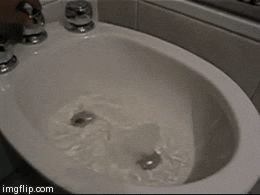“America’s Bathrooms Are a Total Failure,” Rick Paulas writes for Pacific Standard. That may be true. And he may be correct in saying, as the subhead to his article reads, “No matter which American bathroom is crowned in this year’s America’s Best Restroom contest,* it will still have a host of terrible flaws.”
Paulas outlines many of those flaws — from the anatomical infelicity of our toilet seats to the petri-dish nature of our sinks. But the high point of Paulas’ argument, it turns out, is his passionate case for the bidet.
“There are two significant reasons bidets should re-enter our bathroom conversation,” Paulas writes: water conservation and hygiene.
He makes a compelling case on both points. The former point seems surprising, because toilet paper is dry to the touch and the use of it doesn’t involve any water. But as Paulas says, the manufacture of toilet paper is actually quite water intensive:
The creation of one roll of toilet paper actually demands 37 gallons of water (in addition to 1.5 pounds of wood and 1.3Kwh of electricity). One roll, in this case, is 500 sheets of two-ply. Seeing as the average consumer uses 8.6 sheets per trip, in all that’s 37 gallons over 58 trips. Bidets only use about one-eighth of a gallon per use, or 37 gallons for 296 trips.
As for Paulas’ latter point — hygiene — that doesn’t seem at all surprising because, again, toilet paper is dry to the touch and the use of it doesn’t involve any water.
Paulas seems perplexed as to why bidets have “never caught on in America.” I would like to suggest four reasons:
 1. They’re too European. As Paulas notes, the bidet is perceived in America as suspiciously French — making it both effete and vaguely immoral to the American sensibility.
1. They’re too European. As Paulas notes, the bidet is perceived in America as suspiciously French — making it both effete and vaguely immoral to the American sensibility.
2. Common sense. For all of Paulas’ fancy statistics about the 37 gallons of water it takes to create a roll of toilet paper, we still can’t see all that water flowing away when we buy or touch or use toilet paper. We can see the water a bidet uses. So “common sense” tells us they’re a waste of water. And we Americans are too proud of our common sense to waste time investigating whether or not it’s actually correct.
3. Structural inertia. We can’t just go to the store and buy a bidet. Installing one would mean re-doing our plumbing. More than that, it would mean redesigning the architecture of our bathrooms to accommodate the space and plumbing needed for this weird, foreign device. Whatever the merits of Paulas’ claims that our current system is inefficient, wasteful or harmful, it’s undeniably true that our current system is our current system. We’re invested in it. Changing that — even to something arguably better — would involve too much effort and expense.
4. It’s the American way. Whatever value there may be in Paulas’ argument, he’s claiming that the American way is not the best way, and so he’s lost us already. This is the way we do things in America. If it were not the best way to do things, then it wouldn’t be the way we do things here in America because here in the best country on Earth, we do everything the best way. Duh.
Unlike Paulas, I’m not mainly focused here on the matter of bathrooms and bidets. I’ve never actually used a bidet, and despite this compelling article, I’m still not in a rush to do so.
What I find interesting, rather, is that the four reasons I’ve just listed for why Americans are unlikely to adopt the bidet also apply to many other things that Americans are not likely to view favorably, even if perhaps they should.
Like, for example, universal health care.
Or critical biblical scholarship.
Or electric cars.
Just saying.
– – – – – – – – – – – –
* My nominees would be the women’s restroom of The Eagle Tavern in Chester Springs and the unisex restrooms at the A-Plus Mini-mart near the corner of West Chester Pike and 320 in Springfield. You’re welcome.
















